श्री भैरव चालीसा – Shree Bhairav Chalisa or Shri Batuk Bhairav Chalisa in Hindi
Shree Bhairav Chalisa or Shri Batuk Bhairav Chalisa
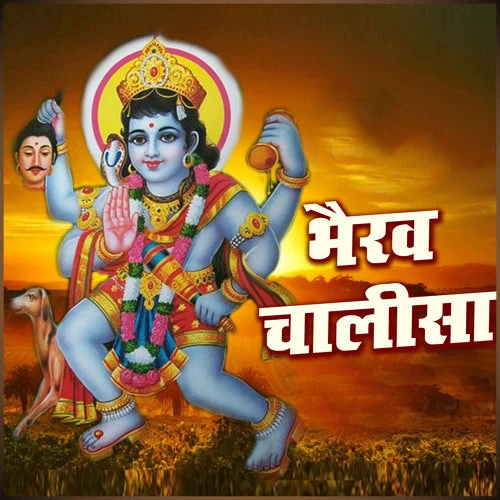
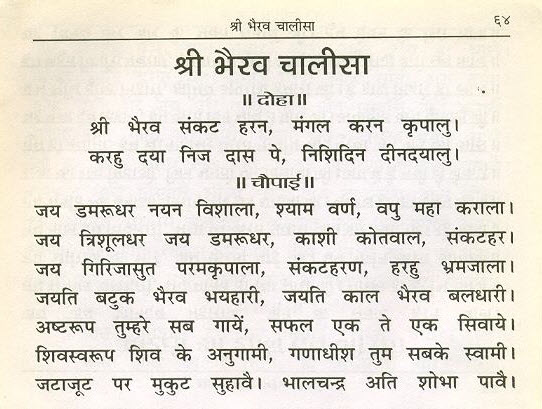

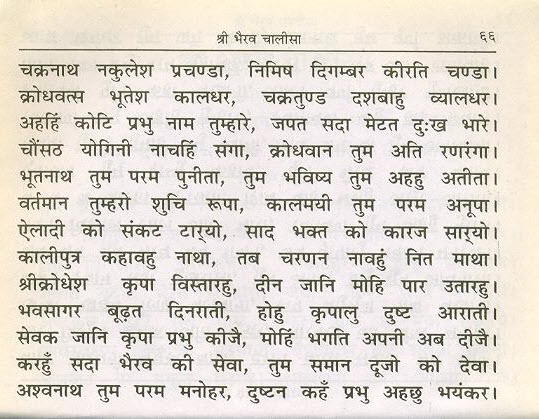

Aarti Shree Bhairav ji ki

Shree Bhairav Chalisa
Doha:
Shri Sankat haran mangal karan kripalu,
Karahu daya nij das pe nishidin din dayalu.
Jai damroodhar nayan vishaala,
Shyam varn vapu maha karaala.
Jai trishuladhar, jai damroodhar,
Kashi kotwal sankat har.
Jai Girijasut param kripala,
Sankat haran harahu bhramjaala.
Jayati Batuk Bhairav bhayahaari,
Jayati kaal Bhairav baladhari.
Ashtaroop tumhare sab gaayein,
Safal ek te ek sivaye.
Shivswaroop Shiv ke anugaami,
Ganadhish tum sabke swami.
Jatajoot par mukut suhaavai,
Bhalchandra ati shobha paavai.
Kati kar dhani ghunghroo baajein,
Darshan karat sakal bhay bhaajein.
Kar trishul damroo ati sundar,
Morpankh ko chhavur manohar.
Khappar khadg liye balwaana,
Roop chaturbhuj nath bakhana.
Vahan shwan sada sukhraasi,
Tum anant prabhu avinaasi.
Jai jai jai Bhairav bhay bhanjan,
Jai kripalu bhakton man ranjan.
Nayan vishaal lal ati bhaari,
Raktavarn tum ahahu puraari.
Bam bam bam bolat din raati,
Shiv kahan bhajahu asur aaraati.
Ek roop tum Shambhu kahaaye,
Dooje Bhairav roop banaaye.
Sevak tumahin prabhu swami,
Sab jag ke tum antaryaami.
Raktavarn vapu ahahi tumhara,
Shyamavarn kahun hoay prachaara.
Shvetavarn puni kaha bakhani,
Teen varn tumhare gun khani.
Teenin nayan prabhu param suhaavahin,
Suranar muni sab dhyaan lagaavahin.
Vyaadh charmadhar tum jag swami,
Pretnath tum poorn akaami.
Chakranath Nakulesh prachanda,
Nimish digambar keerti chanda.
Krodhvats Bhootesh kalakshar,
Chakratund dashabahu vyaaldhar.
Ahahin koti prabhu naam tumhaare,
Japat sada meetat dukh bhaare.
Chaunsath Yogini nachahi sangaa,
Krodhvaan tum ati ran rangaa.
Bhootnath tum param puniita,
Tum bhavishya tum ahahu atiita.
Vartamaan tumhro shuchi ruupa,
Kaalmayi tum param anuupa.
Aikadi ko sankat taaryo,
Saad bhakt ko kaaraj saaryo.
Kaaliputr kahaavhu naathaa,
Tab charan nahahu nita maathaa.
Shri Kroddhesh kripa vistaarahu,
Din jaani mohi paar utaarahu.
Bhavsaagar boodhat din raati,
Hohu kripalu dusht aaraati.
Sevak jaani kripa prabhu kiijai,
Moin bhakti apni ab diijai.
Karhu sada Bhairav ki seva,
Tum samaan doojo ko deva.
Ashwanath tum param manohar,
Dusht kahan prabhu ahchu bhayankar.
Tumharo daas jahaan jo hoy,
Taakahu sankat pare na koy.
Harahu nath tum jan ki peera,
Tum samaan prabhu ko bal veera.
Sab aparadh kshama kari diijai,
Din jaani apun moin kiijai.
Jo yah paath kare chaalisa,
Taapai kripa karahu Jagadisha.
Doha:
Jai Bhairav, Jai Bhootpati, Jai Jai Jai Sukhkand.
Karahu kripa nit daas pe dehu sada aanand.
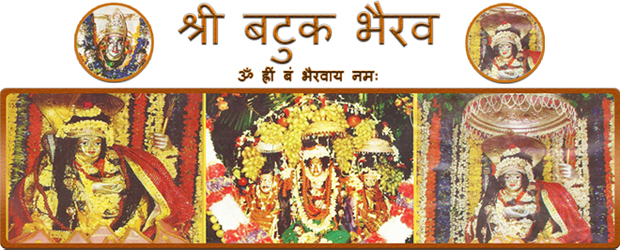
Lord Bhairav
Lord Bhairav is an fierce incarnation of Lord Shiva.The Bal Rup(cradle)of Lord Kala Bhairava is known as Batuk Bhairav. Vigyan Bhairav or Bhairav Tantra text defines Bhairav as Bhaya sarvan ravayati sarvado -vyapako khileIti bhairavo shbdasya santatocharacchivah. The origin of Bhairava can be traced to the conversation between Lord Brahma and Lord Vishnu recounted in “Shiv Maha-Puran” where Lord Vishnu asks Lord Brahma who is the supreme creator of the Universe. Arrogantly, Brahma tells Vishnu to worship him because he (Brahma) is the supreme creator. This angered Shiva who then incarnated in the form of Bhairava to punish Brahma.
Bhairava beheaded one of Brahma’s five heads and since then Brahma has only four heads. When depicted as Kala Bhairava, Bhairava is shown carrying the decapitated head of Brahma. Cutting off Brahma’s fifth head made him guilty of the crime of killing, and as a result, he was forced to carry around the head for years and roam as Bhikshatana, a mendicant, until he had been absolved of the sin.
In the form of the frightful Bhairava, Shiva is said to be guarding each of these Shaktipeeths. Each Shaktipeeth temple is accompanied by a temple dedicated to Bhairava.
Worship
His temples or shrines are present within or near most Jyotirlinga temples, the sacred twelve shrines dedicated to Shiva across India, including Kashi Vishwanath Temple, Varanasi and the Mahakaleshwar Temple at Ujjain, where at the Kal Bhairav Temple, he is worshipped by the Kapalika and Aghori sects of Shaivism, here one can also find the Patal Bhairav and Vikrant Bahirav shrines.
Kaal Bhairava temples can also be found around Shakti Peethas, as it is said Shiva allocated the job of guarding each of 52 Shakti Peethas to one Bhairava. As such it is said there are 52 forms of Bhairava, which are in fact considered as manifestation of Shiva himself.
Traditionally Kal Bhairav is the Grama devata in the rural villages of [Karnataka], Maharashtra and Tamil Nadu, where he is referred to as “Bhaivara/Annadhani”Vairavar.In Karnataka, Lord Bhairava is the supreme god for vokkaliga community commonly referred as “Gowdas”, especially for Gangadikaar Gowda caste he is considered as the care taker and puni
Forms of Lord Bhairav
The eight forms of Bhairavs were created who were positioned at various places in Kashi. These Bhairavs protect the devotees from all sorts of evils and give the devotees happiness and prosperity in their lives.
Krodhan Bhairav is known as Aadi Bhairav and is located at Batuk Bhairav temple at B.31/126, Kamachha, Varanasi. Devotees can reach this place in rickshaw from anywhere in Kashi as Kamachha and Batuk Bhairav are famous places. Some people say that Krodhan Bhairav is the small Bhairav located adjacent to Kamakhya Devi in the temple nearby.
Kapal Bhairav (Laat Bhairav) is located at A.1/123, Alaipur. This falls almost on the outskirts of Varanasi towards the North Eastern side. Devotees can travel in a rickshaw/auto to reach this place. From Ashapur Chowmani, the road to the left goes to Sarnath. Devotees should take the road to the right and travel about 2 kms. to reach Laat Bhairav.
The place of worship is open from 06.00 a.m. to 11.00 a.m. and from 06.00 p.m. to 09.00 p.m. The timings are extremely flexible. Devotees can worship this deity as per their convenience.
Asitang Bhairav is located at K.52/39, Maha Mrityunjay temple near Vriddh Kaleshwar. Devotees can reach this place by rickshaw by travelling through Bisheshwarganj G.P.O. Mrityunjay temple is quite famous.
The place of worship is open throughout the day. Devotees can worship this deity as per their convenience.
Chand Bhairav is located in the temple premises of Durga Devi at B.27/2, Durga Kund. This is a famous locality and devotees can reach this place by rickshaw or auto or car.
Ruru Bhairav, also called as Anand Bhairav by locals, is located at B.4/16, Hanuman Ghat, Varanasi. Devotees can travel upto this place in a rickshaw. Hanuman Ghat is near Harishchandra Ghat, one of the cremation grounds and is a famous place. Devotees will have to get down at Hanuman Ghat main Road and walk towards the Hanuman Temple which is located near Ruru Bhairav.
Types of Bhairava
Kshethra Pala Bhairava
[Guard of Earth Bhairava]
Raktha jwalaa Jada dharam, sasi dharan, Rakthanga thejo mayam, Dakka Shoola kapala pasa gadha dharam Bhairavam, Nirvanam Gathavahanam Trinayanamcha Ananda kolahalam, Vande bhootha pisacha natha vadukam Kshethrasya palam Shubham. 1
I salute the leader of ghosts and Ghouls, Lord Bhairava, Who wears the red flame as his matted hair, Who wears the moon, who shines in red colour, Who holds a drum, spear, skull, rope and mace in his hands, Who is nude, who rides on a dog, who has three eyes, Who is always happy and exuberant and is the guard of the temple.
Asithanga Bhairava
[Dark Bodied Bhairava]
Trinethram, varadam shantham, munda mala bhooshitham, Swetha varnam, krupa murthim, Bhairavam Kundalojjwalam, Gada kapala samyuktham, kumarsya digambaram, Banam pathrancha sankham cha Aksha maalaam kundalam, Naga Yagnopaveetham cha dharinam suvibhooshitham, Brahmani shakthi sahitham, hamsaroodam suroopinam, SArvabheeshta dharam nithyam asithangam Bhajamyaham. 2
I pray the dark Bhairava who fulfills all desires, Who is forever, who has three eyes, who blesses and is peaceful, Who wears a skull garland, who is white, who is the Lord of mercy, Who shines in his ear globes, who holds mace and the skull, Who is young and nude, who holds arrow, vessel, conch, bead chain and ear globes, Who wears snake as sacred thread, who is well ornamented, Who is with Goddess Brahmani, rides on a swan and is good to look at.
Krodha Bhairava
[Angry Bhairava]
Trinethram, varadam, santham, kumarancha digambaram, Gadam shankam cha Chakrancha pada pathrancha dharinam, Lakshmyacha sahitham vame garudasana susthitham, Neela varnam maha devam Vande Sri Kroda Bhairavam. 3
I salute the angry Bhairava, who is blue and a great God, Who has three eyes, blesses, peaceful, young and nude, Who is armed with mace, conch, wheel, rope and a vessel, Who is near Goddess Lakshmi riding on Garuda the eagle.
Unmatha Bhairava
[Frantic Bhairava]
Trinethram, varadam, santham, kumarancha digambaram, Hema Varnam, maha devam, hastha vahana susthitham, Gadgam, kapalam, musalam, dathantham, kedagam thadha, Varahi shakthi sahitham Vande Unmatha Bhairavam. 4
I salute that Frantic Bhairava who is power called Varahi, Who has three eyes, blesses, peaceful, young and nude, Who is of golden colour, great God and rides on a swan, And who holds sword, skull, Pestle and also the shield.
Ruru Bhairava
[Teacher Bhairava]
Trinethram, varadam, santham, kumarancha digambaram, Dangam krisna mrugam pathram bibranam chakru panakam, Maheswaryayudham devam vrusharoodam smitha vahanam, Shudha sphatikam sankaram, namami Ruru Bhairavam. 5
I salute the Bhairava with the deer, who is like pure crystal and a destroyer, Who has three eyes, blesses, peaceful, young and nude, Who holds a hatchet, deer, drinking goblet and a sword in his hands, Who has the armed Maheswari by his side and who is smiling and rides on a bull.
Kapala Bhairava
[Skull Bhairava]
Trinethram, varadam, santham, kumarancha digambaram, Pasam, Vajram, thadha Gadgam pana pathranch dharinam, Indrani shakthi sahitham Gaja vahana susthitham, Kapala Bhairavam Vande padma ragha prabham Shubham. 6
I salute the Bhairava of the skull, who has a shining body, Who has three eyes, blesses, peaceful, young and nude, Who holds rope, Vajrayudha, Sword and Drinking Goblet, Who has with him Indrani Shakthi, is being well praised and rides on an elephant.
Chanda Bhairava
[Fierce Bhairava]
Trinethram, varadam, santham, kumarancha digambaram, Dhanur banancha bhibranam, Gadgam Pathram Thadaiva cha, Koumari shakthi sahitham, Shikihi vahana sthitham, Gowri varnayudham Devam Vande Sri Chanda Bhairavam. 7
I salute the Chanda Bhairava who is pure white in colour, Who has three eyes, blesses, peaceful, young and nude, Who holds rope, Vajrayudha, Sword and Drinking Goblet, Who has with him Kaumari Shakthi and rides on a peacock.
Bheeshana Bhairava
[Terriffic Bhairava]
Trinethram, varadam, santham, kumarancha digambaram, Gadgam soolam Kapalancha darinam musalam thadha, Chamunda shakthi sahitham pretha vahana susthitham, Raktha varnam maha devam Vabde Bheeshana Bhairavam. 8
I salute the Terriffic Bhairava who is a great God of blood red colour, Who has three eyes, blesses, peaceful, young and nude, Who holds sword, trident, skull and pestle in his hand, Who has with him Chamunda Shakthi and rides on a corpse.
Samhara Bhairavam
[Annihilator Bhairava]
Dasa bhahum trinethram cha sarpa yagnopaveethinm, Damishtra karala vadanam ashtaiswarya pradhayakam, Digambaram kumarancha simha vahana samsthitham, Soolam damarugam shankam, gadam chakrancha darinam, Gadgam pathram cha Gadwangam pasa mangusa meva cha, Ugra roopam madonmathamam bada vaalai, Chandika shakthi sahitham dyayeth samhara Bhairavam. 9
I meditate on Bhairava the destroyer, who is with Chandika Shakthi, Who has ten hands, three eyes and snake as sacred thread, Who has protruding teeth, fearful look and grants eight type of wealth, Who is nude, a youth and rides on a lion, Who holds trident, drum, conch, mace and wheel in his hands, Who holds sword, vessel, Gadwangam, rope and goad. And who has fearful looks, wears skull garland and greatly exuberant.
Bhairav Stuti
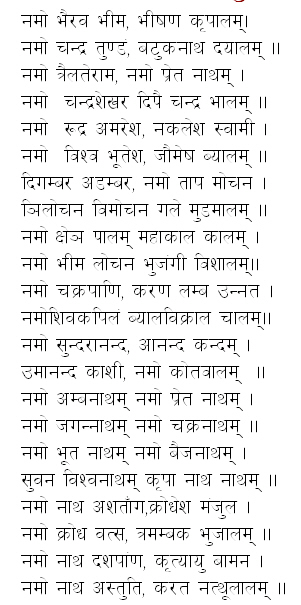

can you translate the bairav chalisa into english so that we can know the meaning of what it is saying thank you …